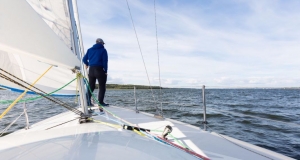Sailing is when you are using the wind as a means of propulsion whilst in a boat. The sailor very skilfully manages the sails by making sure they are the correct angle to the wind in order to move in different directions.
Sailing is a means of transportation, a popular sport and recreational activity. Sailing for recreation can also be called yachting and is separated into the categories, racing and cruising. With the right weather, sailing is a great day out meandering around the coastline or travelling across the ocean. There is a sailing event in the Olympic Games held on closed courses with specific rules applied. It is advisable to undertake thorough research before buying a boat and learn about sailing through people that have experience in the activity.
Keep scrolling down the page to learn more about this hobby. HobbyFinda has over 300 exciting hobbies to explore and with the use of our HobbyFinda Calculator, we make it easy for you to find a hobby the fun way!
Open Water Sailing – Choosing the Right Vessel
By Mike Dickens
Ocean – seafaring is more than just pleasure, it is an instructive stage, a transportation system for understanding, and a distribution system for awareness. Ocean sailing offers both physical and psychologically challenges.
Blue water cruising can be one of the most discouraging and pleasurable sports there is, together at the same time. Ocean cruising people have learned how to manage their lives and personal relationships because they have to. Ocean seafaring presents genuine problems that require true solutions, that can’t be disregarded. Survival on the high seas is the only option.
Ocean cruising presents an educational opportunity that has full prospect for the intensification of understanding, survival skills, and attitudes that are difficult to teach in the restrictions of a classroom. Sailing is an unbelievable tool for developing individual and team skills. Bluewater sailing is first, the most splendid and energizing experience to be had. But it has its unusual risks that require exceptional thought to steer clear of
Sailing craft were used by the working class of the Mediterranean area many thousands of years before the birth of Jesus. But styles have changed as have the sailors themselves. Builders of bluewater sailboats have resolved how sailboats are sailed these days into consideration, allowing for the added mass and swiftness the yachts buyers demand. And of course, open water sailboats are compromises in every respect
Vessels constructed for swiftness are much frailer than those constructed for their power and strength. But a boat’s seaworthiness has a lot to do with a seaman’s awareness. Seaworthiness means something very dissimilar on protected lakes than on exposed seas.
When stability is compromised the yacht is not equal to the conditions that she is facing. Maybe the subsequent broader meaning is nearer to what present-day designers aim for; a seaworthy craft is one that is able to pull through quickly from a 180-degree turtle over without acute damage and without going under. Burly enough to care for herself while underway, obedient on the helm, and smoothly handled at all times, agile downwind and able to beat to windward, or at least hold her place, in all but the gravest of conditions. She must able to convey ample crew with outstanding comfort and safety, plus carry ample water and provisions, for lengthy periods and be able to supply good speeds on extensive voyages.
In Principles of Yacht Design, Larsson and Eliasson write that the seaworthiness of a sea cruiser depends on its dynamic behavior in heavy seas; and dynamic affects, clearly, are much more convoluted to gage or foresee than fixed effects. (Any boat may be turned turtle by a crashing wave with a height fifty-five percent of her overall length.
Imagery of blue water yachts cite names for instance, Ocean, Tayana and Roberts. So what are the noteworthy attributes to look for in a deep-sea sailboat?
Satisfying to look at. Can you be loyal to the boat–you recognize there will be issues with her, so she must make your heart flutter while you toil through them and accept them or else you’ll get disgruntled early on.
Thirty-five – forty five feet on deck. Sizeable enough to be sea-kindly and reliable in dreadful weather, yet modest enough for one to handle if necessary.
First rate survey. First-class condition and construction, and a dry sailor. No reason to keep the whole lot covered in plastic.
Good outside ventilation. . Air conditioning will not be a main worry on the high seas.
Full displacement yacht with a full keel. Able of taking charge of you in vile weather while you hunker down beneath decks.
Inboard diesel engine power-driven at not less than 3 hp/ton. Adequate power to make your way motoring or motor-sailing when needed, or to power up and get out of a risky situation.
Thick fiberglass hull. Painless to look after.
Fiberglass decks (no teak). Straightforward to watch over, and no leaks.
Lots of reachable and airy storage. These will be your billets, so you need enough space for reading materials and other comforts, as well as all the extra parts, sailing paraphernalia, etc. for blue-water cruising.
Bulwarks with drains. Exceptional solid footing while moving about the deck areas on board the craft, and good drainage in intense rain or taking on sea water.
Sturdy through-bolted deck cleats. Tough connections for dock lines.
Dual anchors, one with at least 400′ chain. A second anchor for cyclone conditions, and lots of chain for ordinary circumstances.
100 gallon fuel tanks. An ample amount to give you a range of at least 500 nautical miles under power.
Full-size water tanks. Plenty to last the party 3-4 weeks absent rain catching, or water making capabilities.
Small aft cockpit with drains and beefy pad eyes for connection. Relaxing and safe for whoever’s on duty, and safe in a seaway, with capability to drain fast if much water is shipped.
Aluminum keel-stepped mast. Negligible maintenance and extra reinforcement than deck-stepped.
First-rate handholds and foot space on deck for moving around. Critical for protection aboard.
Decent handholds and headroom below. Headroom for a 6′ individual, and sturdy handholds for moving around down below when the seas are up.
Sails: Jib with roller furling. Simple to handle from the cockpit.
Sails: Staysail. Bulletproof method, no furling gear to jam, and trouble-free to take off and switch to storm jib.
Sails: Storm jib. For use on the inner forestay (replacing the staysail) in thunderstorm situations.
Sails: Storm trysail with independent mast track. For service in a storm, without having to get rid of the mainsail. Also, helpful for steadiness while sailing downwind.
Dodger, splash cloths, and bimini. Dodger with effortless visibility forward to keep the blustery weather out of the cockpit, and together with splash cloths keep crew in the cockpit dry as a bone when water is shipped, and a bimini to shadow us from the hot sun.
All berths accommodating 6′. Good for sleeping, and comfort for tall crew members.
Refrigeration. Negligible electrical requirements but yet enough room to keep perishables cool, a freezer would also be excellent to have aboard.
Engine starting battery split from house batteries with a battery monitoring arrangement. Adequate electrical storage to illuminate and chill the boat, as well as run our basic electrical apparatus without unwarranted recharging requirements.
Autopilot. To take the edge off the helmsman when under power.
Wind vane. To substitute for the helmsman while sailing without exhausting the battery.
Emergency boarding ladder A simple to drop and recover swim ladder on the side of the yacht
Lee cloths for the berths. Luxury and sanctuary for the off-watch crew to rest below.
Three-burner propane stove-top with oven. Able to roast pretty much whatever we want.
Directions for all the equipment. So you can mend things, or find out where to go for replacement parts.
Maintenance logs. To know how old the rigging is, what the service record is for the engine, hull, plumbing, and electrical systems, etc.
Diesel stove. To keep you cozy on cold nights.
Life raft, MOB unit, flares, fire blanket, propane and CO detectors, and fire extinguishers. Necessary safety equipment.
Radios—VHF marine and Single Side Band. Indispensable communication gear.
Dinghy with outboard. Capability to get around when at anchor.
Radar. Important for course-plotting at night when close to land, or in shipping lanes, or in fog. Also a fabulous device when approaching an unknown anchorage with a hard-to-find way in, or entering or leaving a dock at night.
Wind instruments (vane and speed) and depth sounder. Depth sounder indispensable, wind instruments extremely useful.
Article Source: ArticleBase

















